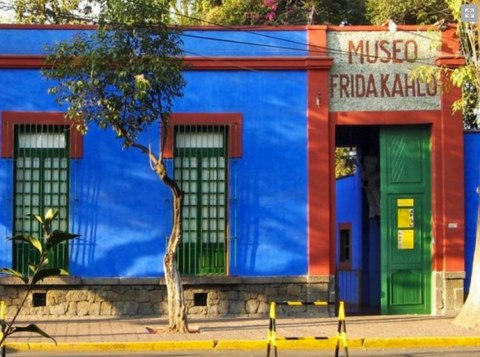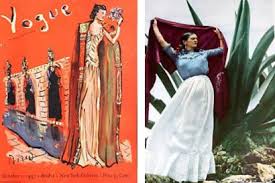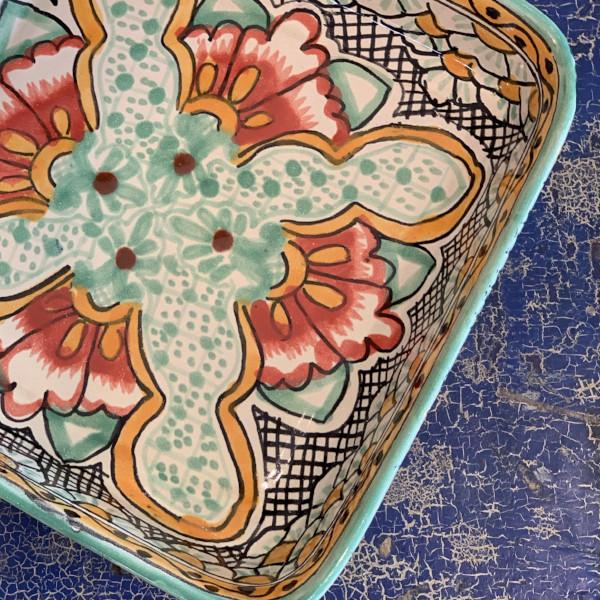
In the Coyoacan neighborhood of Mexico City, you can visit Frida Kahlo’s former home, La Casa Azul, to get a look at the way she lived her life, including where she painted, cooked, slept and entertained. And now you can also see the clothing she wore. Recently, curators of the museum gained access to more of Frida’s clothing, medicines, and other personal effects. Her personal items had been locked away from prying eyes since her death in 1954 on the orders of a grieving Diego Rivera. A traveling exhibition in 2014 called, “Appearances Can Be Deceiving,: The Dresses of Frida Kahlo” featured Kahlo’s clothing, and offered the world a view into some of her most personal habits and challenges.

Frida Kahlo wore and painted herself in traditional Mexican blouses and huipiles from several regions of Mexico. But her Tehuantepec-style garb, suited both her cultural and physical interests. Wearing the blouses of her mother’s native region allowed her to show her support for that matriarchal sub-culture and contrasted with the more common European styles of the time. In addition, the long, flowing skirts and huipiles that Kahlo wore offered a pretty way to cover her polio-deformed leg. Her style was so unusual and striking that she was featured in American Vogue in 1937, and her fashion and style choices continue to influence the modern design world.

In addition to the long skirts, elaborate headpieces, and intricate jewelry, the traditional Tehuana element that Kahlo often chose included a square-cut blouse, known as a huipil.

A huipil (pronounced, wee-peel) is a blouse made from simple rectangles of fabric with a hole for the head. These garments often feature a weaving pattern that communicates personal information about the weaver/wearer or other cultural aspects of life. Huipiles are constructed out of one, two or even three rectangular pieces (as they are more commonly made in Chiapas). The seams are closed by hand, sometimes incorporating decorative embroidery or ribbons as a design element. Sometimes they are left open to more easily fit over other clothing. A neckline is cut and finished at the end, or is created by leaving an opening in the middle of a seam. Huipiles are most commonly made from cotton, although velvet is also used for special occasions particularly in Tehuantepec.
Huipiles are meant to be worn with a casual, loose fit, and in the past were wider than than they were long, although the width has narrowed over time. Originally, huipiles were longer in length, functioning more as dresses. Then as European influence grew stronger after the Spanish conquest of the Aztec Empire, huipiles were sometimes worn shorter in length and paired with skirts, which is how they are often worn now.
If you plan to order a huipil from us online, consider measuring the width across the bust of one of your other woven (non-stretchy) shirts in order to check the fit of your purchase. Huipiles can also be belted at the waist, or tucked into a waistband. Most of the huipiles at Zinnia Folk Arts are handwoven in Chiapas, Oaxaca, Guerrero, and Michoacán (where they are also called huanengo).
Embroidery and decoration of huipiles varies greatly by region, and even the pattern of the weaving can have significance. In Mayan or other communities that wear them, the designs on the front and back shoulders can identify their lineage and specific community.
The indigenous women of the Isthmus of Tehuantepec, who so greatly influenced Frida Kahlo, have a special occasion face-framing “huipil de tapar” (covering huipil), which frames the face and then extends over the neck and shoulders.

Huipiles from Chiapas incorporate symbols from the natural and spiritual aspects of their world, including images of gods, flowers and frogs. They also often include symbols representing the signature of the weaver.
Embroidery on huipiles was entirely handsewn in the past, but now it is sometimes aided by machine sewing. While this does not mean that it was less work, it is good to remain vigilant that a huipil you select is actually made by a Mexican artisan, rather than a factory in China. A very low price would be one red flag for such a copy.
Please contact us in the store if you have questions about how we select our huipiles or about any particular huipil you may be considering.
While we do not often dress as elaborately as Frida Kahlo did, huipiles can be easily displayed on a wall. We appreciate and enjoy huipiles for their high level of comfort and function but also for their distinctive beautiful style. We hope that you will love yours too!
REFERENCES
http://abcnews.go.com/ABC_Univision/frida-kahlo-fashion-exhibit-opens-mexico-city/story?id=17810830
http://www.collectorsweekly.com/articles/uncovering-clues-in-frida-kahlos-private-wardrobe/
http://www.statemuseum.arizona.edu/exhibits/frida/web/textiles.shtml
http://fashion-history.lovetoknow.com/clothing-around-world/history-dress-central-america-mexico
https://en.wikipedia.org/wiki/Huipil



